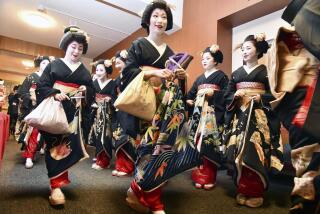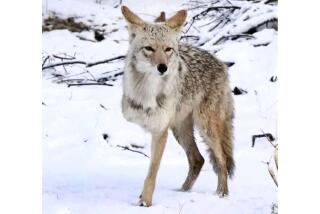In Nara, Japan, the deer know their place: everywhere
One of the great side benefits of visiting Japan is the food, especially the sushi and sashimi. But for those travelers willing to go the extra mile, there is a little-known city where visitors go to feed the locals rather than to dine among them.
The city of Nara lies south of Kyoto, less than two hours from Tokyo by train, but to travel here is to journey back in time.
From 710 to 784, it was the capital of Japan and known as Heijo-Kyo. Today it is a beautiful city of 370,000, full of temples and shrines and home to one of the world’s largest wooden buildings and one of the largest known statues of Buddha.
Planning your trip to visit Nara’s deer
GETTING TO JAPAN
From LAX, connecting service (change of planes) to Osaka, the closest airport to Nara, is available on All Nippon, JAL, Delta, Asiana and United. Restricted round-trip fares begin at $800.
TO LEARN MORE
Nara Tourism, www.pref.nara.jp/nara_e
To walk its streets is to enter the old Japan of kimonos and geta, or wooden sandals, but the traveler must watch his or her step, because in Nara there seem to be as many deer as people, and they have the complete right of way. Deer, by the way, are grazers, which means they eat around the clock. The deer of Nara live to eat and are not fussy about what that may be.
Local mythology says a deity named Takemikazuchi arrived in the old capital on a white deer to act as its protector, and as a result of this legend, for the last 1,300 years the deer of Nara have been considered sacred.
You are likely to meet one as soon as you step off the train, and you will also find them walking the streets and inside the stores, shops and restaurants. Although the local people are used to them, it may take a little adjusting for the casual visitor to feel at ease because their sacred status has made the deer of Nara aggressive.
They may join you in an elevator or inside a public restroom. If they cross the street, the cars will stop and the local police will hold up traffic until they are clear.
The city’s main occupation seems to be feeding the thousands of deer, and there are signs and vendors everywhere, not to mention vending machines, as well as countless movable carts, all selling shika senbei, or deer crackers. At the vending machines the deer will push you aside to get at the chute, and they flock to the carts where they can overwhelm the unwary. They will push and head butt, nibble on one’s clothes and, as my wife found out, eat a woman’s purse in their pursuit of food.
While I was trying to photograph them, two chewed on my camera while another removed the keys from my jacket pocket and chewed them into uselessness. I watched them eat food and the wrappers it came in, plastic, paper -- you name it. When a Nara deer begins to eat, nothing stands in its way.
When my wife and I tried to have a small picnic on a park bench, the deer mobbed us and took our sandwiches and drank our sodas. But they are not ungrateful. Most of them have learned to bow after receiving a treat, as is the local custom. Bowing to show respect is a way of life in Japan, but only in Nara will you see people bowing to deer and the deer bowing back.
In their midst you must be on guard, and to utter even the slightest “Shoo” will bring instant admonishments from the local people. After spending several days’ budget on shika senbei, we retreated to a local restaurant for sushi, finding a stack of biscuits on every table to be used as an offering to buy a moment’s peace for people trying to eat. I became adept at handling chopsticks with one hand and feeding the marauding deer with the other.
Nara may be the only place on Earth where you cannot only watch wildlife but also dine with it at the same time.
travel@latimes.com
More to Read
Sign up for The Wild
We’ll help you find the best places to hike, bike and run, as well as the perfect silent spots for meditation and yoga.
You may occasionally receive promotional content from the Los Angeles Times.






